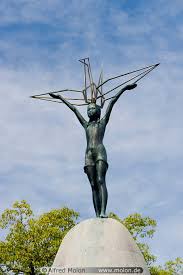Following is the story of the Peace Crane. In the next post I'll show you some more recent origami art.
Story of the Peace Crane
Danuse Murty
Buddhist Council of NSW
For free distribution only
The origami crane has become an international symbol of peace, a Peace Crane, through the sad but inspiring life story of a young Japanese girl named Sadako Sasaki.[1,2]
Sadako was born in 1943 in Hiroshima, Japan. She was two years old when the atom bomb was dropped on Hiroshima, on 6th August 1945.
Following that Sadako seemed to continue growing up well into a happy and healthy girl. In
the 6th grade she was one of the fastest runners in her school and her dream was to become a physical
education teacher.
But towards the end of November 1954, Sadako caught a little cold and lumps developed on her neck and behind her ears, swelling her face as if she had the mumps. Sadako was soon diagnosed with Leukemia, which people in Japan called "the atom bomb" disease. In February she entered the Hiroshima Red Cross Hospital.
In August, while in the hospital, she was shown colourful paper cranes and told an old Japanese legend, which said that anyone who folds a thousand paper cranes would be granted a wish. Sadako hoped that by folding the paper cranes she would get well again. So she began making the cranes and
completed over 1000 of them before dying on October 25, 1955 at the age of twelve.
While making the cranes she also wished and helped towards world peace:
“I will write peace
on your wings
and you will fly
all over the world.”
(Sadako Sasaki)
Her classmates felt deeply sad to lose their dear friend. They discussed what they could do for her, and came up with the idea of building a monument to Sadako and all the children killed by the atom bomb. Young people all over Japan helped collect money for the project. In 1958, a statue of Sadako holding a golden crane was unveiled in Hiroshima Peace Park.
The children also made a wish that is inscribed at the bottom of the statue and reads: 
"This is our cry,
This is our prayer,
Peace
in the world."
Since then people all over the world fold paper cranes and send them to the Sadako's monument in Hiroshima, in memory of Sadako and all children killed through wars.[1,3]
The story of Sadako and peace monument has inspired many people around the world to work towards world peace and to protect the seriously threatened Red-crowned Crane (Grus
japonensis) on which the origami crane and the Japanese legend are based.[3]
Cranes are among the species at the top of a wetland ecological pyramid and hence they are more vulnerable to extinction. Health of the crane population is often a good indicator of the health of the whole wetland ecosystem.[4,5]
Fulfilment of prayers and wishes for world peace depends on a healthy natural environment. Protecting our natural environment is a sign of true wisdom, since our own health and peace depend on it.[6]
References
1. Hiroshima Peace Site, 2009. The Special Exhibit, Sadako and the Paper Cranes.
2. Origami Fun, 2009. Animals, Crane.
3. Wikipedia 2009. Sadako Sasaki; Origami Crane; Redcrowned Crane. www.wikipedia.org
4. International Crane Foundation, 2009. Red-crowned Crane. www.savingcranes.org
5. Wikipedia 2009. Crane. www.wikipedia.org
6. Bodhi Tree 2009. Ebooks, The Book of Protection.
www.buddhistcouncil.org/bodhitree
This is really touching. Kate, who loves to make origami Cranes, will be especially inspired to send Cranes to the monument. I love this!
ReplyDeletePS I still have to use Chrome to be able to post. It won't let me from Firefox.
ReplyDeleteMaybe Kate will be inspired to try her own creation after seeing the next post.
ReplyDeleteI still haven't figured out what the problem is with comments.